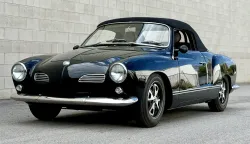

Volkswagen Karmann Ghia - Generation 1 Type 14
Discover the Volkswagen Karmann Ghia, a stunning classic car. Learn more about the Generation 1 Type 14 model and its features popular in Portugal.
The Volkswagen Karmann-Ghia, introduced in 1955, represents an iconic blend of European style and engineering, establishing itself as a favorite among car enthusiasts. The first ge...
Technical Specifications
Select Version
Dimensions
Engine
Driving
Others
History and Features
Mycarro AI
Apr 27, 2025
Introduction
The Volkswagen Karmann-Ghia, introduced in 1955, represents an iconic blend of European style and engineering, establishing itself as a favorite among car enthusiasts. The first generation, known as Type 14, was produced until 1974, where it quickly gained a reputation for its distinctive design and agile driving dynamics. This model marked an important chapter in Volkswagen's history, showcasing the brand's ability to combine practicality with aesthetic charm.
Design and Aesthetics
The design of the Karmann-Ghia was a collaborative effort between Volkswagen and the renowned Italian design house Ghia, led by the famed designer Sergio Sartorelli. Using the chassis of the Volkswagen Beetle, the Karmann-Ghia was transformed into a stylish coupe with sweeping lines and a sophisticated silhouette. Its low profile, round headlights, and unique rear fenders set it apart from conventional cars of the time, creating an aura of timeless elegance that continues to attract attention.
The interior of the Karmann-Ghia was equally appealing, characterized by a driver-oriented cockpit and comfortable seating for two. Though somewhat minimalistic by modern standards, the cabin managed to provide a sense of luxury through its thoughtful design and use of quality materials. The availability of a convertible model further elevated its status as a stylish choice for driving enthusiasts seeking both performance and aesthetics.
Mechanical Features
Under the hood, the Karmann-Ghia featured various air-cooled flat-four engine configurations throughout its production run, illustrating Volkswagen's knack for reliable engineering. The initial variants offered a 1.2-liter engine producing around 30 horsepower, which later evolved into more powerful offerings. The Type 34 variant introduced a 1.6-liter engine option, boosting performance significantly and increasing its appeal among sportier drivers.
The lightweight design of the Karmann-Ghia, combined with its competent suspension system borrowed from the Beetle, provided a lively driving experience. Drivers appreciated the car’s tight handling and responsive steering. This dynamic foundation enabled the Karmann-Ghia to carve through roads with ease, ensuring it could compete with various sports cars of its era.
Popularity and Cult Following
The Karmann-Ghia quickly gained a devoted following, with many drivers enthralled by its blend of sporty character and everyday usability. It became synonymous with the free-spirited culture of the 1960s, as featured prominently in movies and pop culture. Owning a Karmann-Ghia became a symbol of coolness, embodying the societal shift towards leisure and car culture that epitomized the decade.
As years passed, the Karmann-Ghia evolved into a classic collectible, fueling its desirability among vintage car enthusiasts. Enthusiast clubs and communities emerged globally, fostering passion for the vehicle and facilitating restoration projects. Original parts and knowledgeable mechanics became essential resources for owners, as maintaining these vintage beauties became a labor of love.
Production and Legacy
The first generation Karmann-Ghia was produced in various forms, with production numbers exceeding 440,000 units. Its longevity and enduring appeal can be attributed to its unique aesthetics, driving enjoyment, and relatively simple mechanical systems. This made the Karmann-Ghia an accessible entry point into the world of classic cars for many enthusiasts.
As a key part of Volkswagen's lineup, the Karmann-Ghia paved the way for future models within the brand, reflecting a commitment to design excellence and innovation. While production officially ceased in 1974, the legacy of the Karmann-Ghia endures through its status as a classic symbol of automotive history.
Conclusion
The Volkswagen Karmann-Ghia Generation 1 (Type 14) remains an emblem of style and drivability in the automotive world. Its harmonious blend of design and practicality, complemented by a dedicated ownership community, ensures that this remarkable vehicle continues to captivate generations. As time marches on, the Karmann-Ghia will undoubtedly remain cherished, celebrated, and spoken of with great fondness as one of Volkswagen's most iconic offerings.
